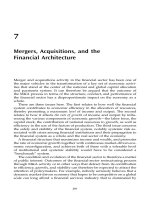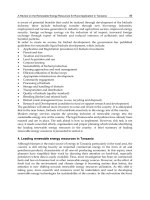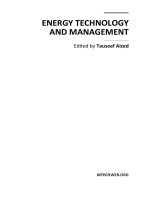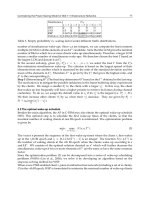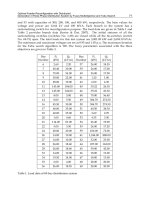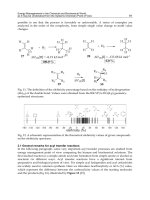Energy Technology and Management Part 4 pdf
Bạn đang xem bản rút gọn của tài liệu. Xem và tải ngay bản đầy đủ của tài liệu tại đây (2.23 MB, 20 trang )
A Study on Design of Fiber-Reinforced
Plastic (FRP) Tubes as Energy Absorption Element in Vehicles
51
Here the observation results on the flat wall of Carbon MWK composite specimens after
impact test were illustrated in Fig. 23 (taper trigger) &24 (device trigger) as examples to
compare the effect of triggers on the energy absorbing mechanisms of FRP tubes. In the case
of taper trigger, as shown in Fig.23, two-side-bending behaviors could be seen. Although
some fiber fractures could be found in the inside bending fronds, many intro/inter
delaminations generated in the middle and outside fronds instead. Additionally, a big
distance could be found between middle and outside layers after the compression was
released. It is considered that the middle fronds sprung back because of the lack of fiber
fractures. On the other hand, as illustrated in Fig.24, the flat wall of carbon MWK tube
shows these features: bending of tube walls towards inside only; many inter and intro-
delaminations in the middle layers; many transversal cracks and fiber fractures in both
surfaces layers. Here, an attention should be paid that although many inter or intro
delaminations occurred, those independent fronds did not separated each other even after it
was released from the control of device. They touch and bent in a similar bending curvature
towards inside.
Outer
Inner
fiber fractures
Central crack
Wedge of debris
Outside
splitting
fronds
4.2 mm
Middle splitting fronds
Big
distance
Fig. 23. Observation of flat wall of Carbon MWK tube after impact test illustrating two-side-
bending behavior, many splitting frond and some fiber fractures (taper trigger)
A Study on Design of Fiber-Reinforced
Plastic (FRP) Tubes as Energy Absorption Element in Vehicles
53
Subsequently, fibers together with resin would be broken and contributed to higher energy
absorption capability.
For a given tube compressed under Inner or Outer types devices with same
R’, quite
different energy managements were found. According to the formulae of (3) and (8), they
should have similar bending energy and bending stresses. However, obviously Inner type
device show greater contribution to energy absorption of FRP tubes. Here the fracture space
is considered as the major factor. When the tube wall has to be bent inwards or outwards,
the fracture space will be shortened in the case of Inner type or expanded in that case of
Outer type device. After the tube wall shears or splits into pieces of “independent” fronds,
in the case of inner type device, these “independent” fronds have to be superposed each
other owing to the shortened fracture space and shoved the adjacent ones below it with the
advancement of the compression process, whereas that will not occur in the case of outer
type device because those fronds are separated in an extended fracture space. When the
adjacent fronds shove each other, they touch tightly and slide in order to get a space and
bend through almost the same bending curvature during the whole compression process,
which will cause frictional stresses on the touched surfaces between any two adjacent
fronds. Frictional stresses action on the surface of fronds, break fiber as well as resin or
generate heat energy at some degree. Apparently, this kind of friction generated by inner
type device contributes to the total absorbed energy greatly. Fairfull and Hull [39] had
investigated the energy absorbed by the frictional processes in the axially crushing of glass
cloth/epoxy tubes. They claimed that frictional energy could account for more than 50% of
the total energy absorbed. If the influences of bending curvatures of fronds are ignored
temporarily, it could be inferred that the inner type device is better than taper trigger, and
taper trigger is better than outer type device, because the friction effect from taper trigger is
considered a blend of half from the inner type device and half from the outer type device.
Fig. 25. Observation on the cross sections of Inner-3 & Inner-5 specimens (the crush zone
which had been under the R region of device illustrates the different radii of bending
curvatures and the propagation of delaminations.)
Energy Technology and Management
54
FRP tubes have a very complicated energy absorption mechanism during progressive
crushing process. It is considered that the energy absorbed by fiber fracture can contribute
to the total absorbed energy significantly. Therefore, an attempt of design of fiber fractures
was carried out in current study with an attempt to apply the FRP tubes as energy
absorption component in a vehicle.
Crushing behavior of FRP tube was considered related in appearance of the bending
behavior of beam. Here mechanism model of a bending beam was used to simulate the
bending fronds of FRP tube. It is found that the bending energy is in direct proportion of
I,
i.e. the moments of inertia of the section area which is determined by the geometry.
Therefore two improvement methods based on design of the bending energy through the
geometry design were proposed. In method of mimic square to circular, two types of
mandrels (r3 and r9 mandrels) with 3mm or 9mm radius modification on the corners were
employed to determine the effect of design of the geometry. It is found that
Es of the CFRP
tubes fabricated on the r9 mandrel were improved significantly as compared to that
fabricated on the r3 mandrel even with the same fiber architecture and similar size of cross
section area. The influence of the geometry is discussed in terms of
I. It is found that trough
a reasonable geometry design, the energy absorption management of FRP tube with a bigger
I can be improved.
In the method of the combining both circular and square, the CFRP tube with a new
geometry, which utilizing both circular cross-section for its higher energy absorption
capability and square cross-section for its assembling convenience with other components,
was designed. Additionally, braiding texture is used as fiber reinforcement form based on
the considerations of cost and preforms fabrication. It was also shown that the braiding
texture is helpful to improve the crushing performance of FRP tube with this kind of
geometry, particularly during the crushing different cross section process such as from
circular tube part to cone part or from cone part to square tube part.
Additionally, a method aims a thicker thickness and a very small bending curvature of
bending fronds according to the formula of bending stress. On the other hand, FRP tubes
generally need a collapse trigger mechanism to generate stable, progressive, high energy
crushing. Therefore, in the study, bending stress was under consideration with collapse
trigger mechanism. The target of present experiments is to design a new collapse trigger for
the practical application of FRP tubes which is possible to enhance their energy absorption
capability.
Four types of devices are designed and used in the axial quasi-static compression tests of
braided carbon/epoxy tube with a circular transversal cross section. They include inner and
outer types with a radius of 3mm or 5mm. It was found that the devices could trigger
progressive crushing similar to taper. However, unlike taper, devices can change the energy
absorption capacity of the crushed materials significantly. Inner type device could be said to
be better than outer type device because of high friction and a smaller radius confers better
energy absorption capability because of high bending stresses.
Additionally an inner type device with a square transverse cross section and
R’2 was
designed for the FRP tube which has a square transversal cross section. The square FRP
tubes were compressed in impact test with the usage of device in order to investigate the
effect of device under dynamic condition. The results are evaluated in comparison with both
taper and equivalent quasi-static values in order to find the effect from the reinforcement
A Study on Design of Fiber-Reinforced
Plastic (FRP) Tubes as Energy Absorption Element in Vehicles
55
form in the impact test with device. It is found that texture structure (such as multi-axial
warp knitted fabric) is better than unidirection in the case of usage of device, because the
texture structure can control fiber layers well in bending behavior. Because of the double
size thickness in one-side bending, apart from the increased the bending energy, bending
stresses are also increased significantly. Many fibers were broken consequently and the fiber
fracture energy i.e.
U
ff
increased greatly. As result, the higher energy absorption capability
could be obtained.
This study was conducted as part of the Japanese National Project "R&D of Carbon Fiber-
Reinforced Composite Materials to Reduce Automobile Weight" supported by NEDO (New
Energy and Industrial Technology Development Organization). The authors would like to
thank Dr. T. Uozumi @ Murata machinery Ltd and Dr. K. Yamaguchi @ Toray Industries, for
their supplied materials and cooperation of fabrication of the specimens.
Notation
U
T
total absorbed energy
U
split
the energy absorbed by splitting the integrated tube wall into pieces of fronds
U
cc
the energy absorbed by the initiation and propagation of the central crack
U
de
the energy absorbed by delaminations
U
bend
the energy absorbed by the bending of fronds
U
f
f
the energy absorbed by fiber fracture
U
fr
the energy associated with friction
l
height of a beam (frond)
F
an external force
s
The crush displacement along longitudinal i.e. x direction
y
max
the maximum distance in y direction
M
the bending moment of the beam (y trial)
x
any point in x direction from 0 to s displacement
E
modulus of the beam (frond)
A
area of cross section
t
thickness
Es
specific energy absorption
corner
I
the
zc
I
of the corner region
f
lat wall
I
the
zc
I of flat wall
lon
g
flat wall
I the
zc
I of long flat wall
short flat wal
l
I
the
zc
I
of short wall
total
I total
zc
I of the FRP tube
Energy Technology and Management
56
w
length of flat wall
R
outside radius of the curvatures of the corner
r
inside radius of the curvatures of the corner
W
the work done i.e. the total absorbed energy
ρ
the density of the material
P
the average load during progressive crushing
s’
the approximate crushing displacement s which ignore the initial displacement
σ
bending stresses
r’
radius of the bending curvature of the frond (beam)
R’
radius of the curvature of the concave or convex part on the device
w
length of flat wall
[1] Rosen, R.W., Mechanics of composite strengthening. In Fiber Composite Materials,
American Society for Metals, Metals Park, OH, pp.37-76, 1965.
[2] Thornton, P.H. & Magee, C.L., “The Interplay of Geometric and Materials Variables in
Energy Absorption”,
Journal of Engineering Materials and Technology, Vol. 99, pp.
114-120, (1977).
[3] Thornton, P. H. “Energy Absorption in Composite Structures,”
Journal of Composite
Materials
, Vol. 13, pp. 247-263 (July 1979)
[4] Cronkhite, J.D., Hass, T.J., Berry, V.L. & Winter, R., Investigation of the crash impact
characteristics of advance airframe structure. USARLT-TR-79-11, 1979.
[5] Farley, G.L., “Energy Absorption of Composite Materials”,
Journal of Composite Materials,
Vol. 17, pp. 267-279, (1983).
[6] Hull, D., “A Unified Approach to Progressive Crushing of Fibre-Reinforced Composite
Tubes”,
Composites Science & Technology, Vol. 40, pp. 377-421, (1991).
[7] Thornton, P.H. & Edwards, P.J., “Energy Absorption in Composite Tubes
”, Journal of
Composite Materials
, Vol. 16, pp. 521-545, (1982).
[8] Farley, G.L. & Jones, R.M., “Crushing Characteristics of Continuous Fiber-
ReinforcedComposite Tubes”,
Journal of Composite Materials, Vol. 26, pp. 37-50,
(1992).
[9] Farley, G.L., “The Effect of Fiber and Matrix Maximum Strain on the Energy Absorption
Capability of Composite Materials”,
Journal of Composite Materials, Vol. 20, pp. 322-
334, (1986).
[10] Hamada, H., Coppola, J.C. & Hull, D., “Effect of Surface Treatment on Crushing
Behaviour of Glass Cloth / Epoxy Composite Tubes”,
Composites, Vol. 23, No. 2, pp.
93-99, (1992).
[11] Hull, D. & Clyne, T.W.,
An Introduction to Composite Materials, Second Edition,
Cambridge University Press, Cambridge, (1996).
[12] Hamada, H., Ramakrishna, S. & Satoh, H., “Crushing Mechanism of Carbon Fibre
/PEEK Composite Tubes”,
Composites, Vol. 26, No. 11, pp. 749-755, (1995).
A Study on Design of Fiber-Reinforced
Plastic (FRP) Tubes as Energy Absorption Element in Vehicles
57
[13] Schmueser, D. & Wickliffe, L.E., “Impact Energy Absorption of Continuous Fibre
Composite Tubes”,
Journal of Engineering Materials and Technology, Vol. 109, pp. 72-
77, (1987).
[14] Dorey, G., “Impact and Crashworthiness of Composite Structures”,
Structural Impact and
Crashworthiness
, Ed. Davies, G.A.O., Vol. 1, pp. 155-192, Elsevier Applied Science
Publishers, London, (1984).
[15] Tao, W.H., Robertson, R.E. & Thornton, P.H., “Effects of Material Properties and Crush
Conditions on the Crush Energy Absorption of Fiber Composite Rods”,
Composites
Science and Technology
, Vol. 47, pp. 405-418, (1993).
[16] Karbhari, Vistasp M., Falzon, Paul J., and Herzberg, Israel “Energy Absorption
Characteristics of Hybrid Braided Composite Tubes,”
Journal of Composite Materials,
Vol. 31, No. 12. pp.1165-1186, (1997).
[17] Farley, Gary L and Jones, Robert M. “Crushing Characteristics of Continuous Fiber-
Reinforced Composite Tubes,”
Journal of Composite Materials, Vol. 26, No. 1, pp. 37-
50 (1992).
[18] Hull, D. “Axial crushing of fiber reinforced composite tubes”, In structural
crashworthiness, ed. Jones, N. & Wierzibichi, T., Butterworths, London, pp. 118-
135, (1983).
[19] Hamada, H., Coppola, J.C., Hull, D., Maekawa, Z, & Sato, H., “Comparison of Energy
Absorption of Carbon / Epoxy and Carbon / PEEK Composite Tubes”,
Composites,
Vol. 23, No. 4, pp. 245-252, (1992).
[20]. Hamada, H., Ramakrishna, S. & Sato, H., “Effect of Fiber Orientation on the Energy
Absorption Capability of Carbon Fiber / PEEK Composite Tubes”,
Journal of
Composite Materials
, Vol. 30, No. 8, pp. 947-963, (1996).
[21] Schmueser, D. W. and Wickliffe, L. E. “Impact Energy Absorption of the Continuous
Fiber Composite Tubes,”
Journal of Engineering Materials and Technology, Vol. 109,
pp. 72-77 (January 1987).
[22] Karbhari, Vistasp M. “Progressive Crush of Resin Transfer Molded Square Tube
Stiffened Beam Elements,”
Journal of Composite Materials, Vol. 31, No. 10. pp.981-
1001 (1997).
[23] Hamada, H., Nakai, A., Kameo, K., and Takeda, N. “Crushing Performance of Braided
Composites,”
Proceedings of the Eighth Japan-U. S. Conference on Composite Materials,
September 24-25, pp. 467-475 (1998)
[24] Mamalis, A.G., Manolakos, D.E., Viegelahn, G.L., Yap, S.M. & Demosthenous, G.A.,
“On the Axial Crumpling of Fibre-Reinforced Composite Thin-Walled Conical
Shells”,
International Journal of Vehicle Design, Vol. 12, No. 4, pp. 450-467, (1991).
[25] Hamada, H., Ramakrishna, S. & Sato, H., “Effect of Fiber Orientation on the Energy
Absorption Capability of Carbon Fiber / PEEK Composite Tubes”,
Journal of
Composite Materials
, Vol. 30, No. 8, pp. 947-963, (1996).
[26] Farley, G.L. & Jones, R.M., “Crushing Characteristics of Composite Tubes with “Near-
Elliptical” Cross Sections”,
Journal of Composite Materials, Vol. 26, No. 12, pp. 1741-
1751, (1992).
[27] Kindervater, C.M., “Energy Absorption of Composites as an Aspect of Aircraft
Structural Crash-Resistance”,
Developments in the Science and Technology of Composite
Materials
, Ed.s Fuller, J. et al., pp. 643-651, Elsevier Applied Science Publishers,
London, (1990).
Energy Technology and Management
58
[28] Mamalis, A.G., Yuan, Y.B. & Viegelahn, G.L., “Collapse of Thin-Wall Composite
Sections Subject to High Speed Axial Loading”,
International Journal of Vehicle
Design
, Vol. 13, No. 5-6, pp. 564-579, (1992).
[29] Y. Yang, Y. Nishikawa, A. Nakai, U. S. Ishiaku, H. Hamada, “Effect of cross-sectional
geometry on the energy absorption capability of unidirectional carbon fiber
reinforced composite tubes”,
Science and Engineering of Composite Materials. Vol.15,
pp. 249-263, 2008.
[30] FARLEY, G.L., “The Effects of Crushing Speed on the Energy-Absorption Capability of
Composite Tubes”,
Journal of Composite Materials, Vol. 25, pp. 1314-1329, (1991).
[31] MAMALIS, A.G., MANOLAKOS, D.E., DEMOSTHENOUS, G.A. & IOANNIDIS, M.B.,
“Axial Collapse of Thin-Walled Fibreglass Composite Tubular Components at
Elevated Strain Rates”,
Composites Engineering, Vol. 4, No. 6, pp. 653-677, (1994).
[32] A.G. Mamalis, D.E. Manolakos, M.B. Ioannidis and D.P. Papapostolou, ‘On the response
of thin-walled CFRP composite tubular components subjected to static and
dynamic axial compressive loading: experimental’,
Composite Structures, Vol.69
pp.407-420, (2005).
[33] D. Hull, ‘Energy Absorption of Composite Materials under Crash Conditions’,
Proceedings of the Fourth International Conference on Composite Materials (ICCM IV),
1982, 1, 861-870.
[34] J. Berry and D. Hull, ‘Effect of speed on progressive crushing of epoxy-glass cloth
tubes’,
Conf. Ser. Inst. Phys, Vol.70, pp.463-470, (1984).
[35] MAMALIS, A.G., MANOLAKOS, D.E., DEMOSTHENOUS, G.A., IOANNIDIS, M.B.,
The static and dynamic axial collapse of fibreglass composite automotive frame
rails.
Composite Structure, Vol.34, pp.77-90, (1996).
[36] Sigalas, I., Kumosa, M., and Hull, D., Trigger mechanisms in energy-absorbing glass
cloth/epoxy tubes, Composite science and technology, Vol.40, pp.265-287,(1991).
[37] Czaplicki, M.J. et al, Comparison of Bevel and Tulip Triggered Pultruded Tubes for
Energy Absorption, Composite Science and Technology, Vol.40, pp.31-46,(1991).
[38] Saito, H. et al, Crushing properties of pultruded glass reinforced square tubes,
International Journal of Crashworthiness, Vol. 7, No.1, pp.21-33 (2002).
[39] Fairfull, A.H. and Hull, D., Energy Absorption of Polymer Matrix Composite Structures:
Frictional Effects, Structural Failure, Ed.s WIERZBICKI,T. and JONES,N., pp.255-
279,(1988).
3
Optimal Feeder Reconfiguration
with Distributed Generation in
Three-Phase Distribution System by
Fuzzy Multiobjective and Tabu Search
Nattachote Rugthaicharoencheep and Somporn Sirisumranukul
King Mongkut’s University of Technology North Bangkok
Thailand
1. Introduction
Distribution systems are normally configured radially for effective coordination of their
protective devices (Kashem et al., 2006). Two types of switches are generally found in the
system for both protection and configuration management. These are sectionalizing switches
(normally closed switches) and tie switches (normally opened switches) (Su & Lee, 2003). By
changing the status of the sectionalizing and tie switches, the configuration of distribution
system is varied and loads are transferred among the feeders while the radial configuration
format of electrical supply is still maintained and all load points are not interrupted. This
implementation is defined as feeder reconfiguration. The advantages obtained from feeder
reconfiguration are, for example, real power loss reduction, balancing system load, bus voltage
profile improvement,(Baran & Wu, 1989) increasing system security and reliability, and
power quality improvement (Kashem, et al., 2000).
Over the last decade, distribution systems have seen a significant increase in small-scaled
generators, which is known as distributed generation (DG). Distributed generators are grid-
connected or stand-alone electric generation units located within the distribution system at
or near the end user. Recent development in DG technologies such as wind, solar, fuel cells,
hydrogen, and biomass has drawn an attention for utilities to accommodate DG units in
their systems (Gil & Joos, 2008, Jones & Chowdhury, 2008, Quezada, et al., 2006, Carpaneto,
et al., 2006). The introduction of DG units brings a number of technical issues to the system
since the distribution network with DG units is no longer passive.
The practical aspects of distribution system should also be considered for the
implementation of feeder reconfiguration. The actual distribution feeders are primarily
unbalanced in nature due to various reasons, for example, unbalanced consumer loads,
presence of single, double, and three-phase line sections, and existence of asymmetrical line
sections. The inclusion of system unbalances increases the dimension of the feeder
configuration problem because all three phases have to be considered instead of a single
phase balanced representation. Consequently, the analysis of distribution systems
necessarily required a power flow algorithm with complete three-phase model.
This paper emphasizes on the implementation of feeder reconfiguration to the
distribution system with distributed generators. Three objectives to be minimized are real
Energy Technology and Management
60
power loss, feeder load balancing, and number of switching operations of tie and
sectionalizing switches. Each objective is modeled by fuzzy set to specify its membership
value which represents the satisfaction of the objective. The optimal on/off patterns of the
switches that compromise the three objectives while satisfying specified constraints is
determined using fuzzy multiobjective and Tabu search algorithm. The effectiveness of
the methodology is demonstrated by a practical sized distribution system consisting of 69
bus and 48 load points.
2. Feeder reconfiguration
Feeder Reconfiguration is a very important and usable operation to reduce distribution
feeder losses and improve system security. The configuration may be varied via switching
operations to transfer loads among the feeders. Two types of switches are used: normally
closed switches (sectionalizing switches) and normally open switches (tie switches) (Baran
& Wu, 1989). By changing the open/close status of the feeder switches load currents can
be transferred from feeder to feeder. During a fault, switches are used to fault isolation
and service restoration. There are numerous numbers of switches in the distribution
system, and the number of possible switching operations is tremendous. Feeder
reconfiguration thus becomes a complex decision-making process for dispatchers to
follow. There are a number of closed and normally opened switches in a distribution
system. The number of possible switching actions makes feeder reconfiguration become a
complex decision-making for system operators. Figure 1 shows a schematic diagram of a
simplified primary circuit of a distribution system (Baran & Wu, 1989). In the figure, CB1-
CB6 are normally closed switches that connect the line sections, and CB7 is a normally
open switch that connects two primary feeders. The two substations can be linked by CB8,
while CB9, when closed, will create a loop.
Fig. 1. Schematic diagram of a distribution system
Optimum operation of distribution systems can be achieved by reconfiguring the system to
minimize the losses as the operating conditions change. Reconfiguration problem essentially
belongs to combinatorial optimization problem because this problem is carried out by
taking into account various operational constraints in large scale distribution systems. It is,
therefore, difficult to rapidly obtain an exact optimal solution on real system (Chung-Fu,
2008). A flowchart for feeder reconfiguration algorithm is shown in Fig 2.
Optimal Feeder Reconfiguration with Distributed
Generation inThree-Phase Distribution System by Fuzzy Multiobjective and Tabu Search
61
Fig. 2. Flowchart of feeder reconfiguration for loss reduction
3. Tabu search
3.1 Background
Tabu search is a meta-heuristic that guides a local
heuristic search strategy to explore the
solution space beyond local optimality. Tabu search was developed by Glover and has been
used to solve a wide range of hard optimization problems, such as resource planning,
telecommunications, financial analysis, scheduling, space planning, and energy distribution
(Dengiz & Alabas, 2000).
The basic idea behind the search is a move from a current solution
to its neighborhood by effectively utilizing a memory to provide an efficient search for
optimality. The memory is called “Tabu list”, which stores attributes of solutions. In the
search process, the solutions are in the Tabu list cannot be a candidate of the next iteration.
As a result, it helps inhibit choosing the same solution many times and avoid being trapped
into cycling of the solutions (Glover, 1989). The quality of a move in solution space is
Energy Technology and Management
62
assessed by aspiration criteria that provide a mechanism (see Fig. 3) for overriding the Tabu
list.
Aspiration criteria are analogous to a fitness function of the genetic algorithm and the
Bolzman function in the simulated annealing.
Fig. 3. Mechanism of Tabu list
3.2 Neighborhood
In the search process, a move to the best solution in the neighborhood, although its quality
is worse than the
current solution, is allowed. This strategy helps escape from local optimal
and explore wider in the
search space. A Tabu list includes recently selected solutions that
are forbidden to prevent cycling.
If the move is present in the Tabu list, it is accepted only if
it
has a better aspiration level than the minimal level so far. Fig. 4 shows the main concept of
a search direction in Tabu search (Mori & Ogita, 2002).
Initial Solution
x
0
x
1
x
2
x
3
x
4
x
5
x
6
x
7
x
8
x
9
Local Minimum
N
0
N
1
N
2
N
3
N
4
N
5
N
6
N
7
N
8
N
9
Fig. 4. Search direction of Tabu search
An application of the Tabu search algorithm is shown by a three-feeder distribution system
in Fig. 5 (Su, C. T. & Lee, C. S. 2003). The system consists of 16 buses, 13 load points, 13
normally closed switches, and 3 normally open switches. The initial configuration states that
switches located on branch No. 14, No. 15 and No. 16 are open. With this configuration,
the initial power loss is 511.44 kW. Fig. 6 shows moves from the current solution to two
feasible solutions generated by the Tabu search: neighborhood solutions 1 and 2. The moves to
solutions 1 and 2 give a power loss of 676.63 kW and 483.87 kW, respectively. The same process
Optimal Feeder Reconfiguration with Distributed
Generation inThree-Phase Distribution System by Fuzzy Multiobjective and Tabu Search
63
continues until 100 iterations. The optimal solution indicates that switch No. 16 remains
open and the statuses of switches No. 7 and 8 are changed from ‘closed’ to ‘open’, giving a
real power loss of 466.12 kW.
Fig. 5. Single-line diagram of 16-bus distribution system
Fig. 6. Neighborhood search for tie and sectionalizing switches
4. Membership function of objective
A. Membership function for power loss
The power loss is calculated by
Energy Technology and Management
64
l
2
PIR
LOSS
kk
k=1
=
(1)
Where
P
LOSS
=total power loss
I
k
=current flow in branch k
R
k
=resistance of branch k
l =number of feeders
Let us define the ratio of power loss as (Das, 2006).
P
,t
LOSS
PL =
t
P
LOSS,0
(2)
The membership function of power loss is assigned to be trapezoidal fuzzy number
demonstrated in Fig. 7. It is fully satisfied if the system loss is smaller than PL
min
. Between
PL
min
and
PL
max
, the satisfaction level declines as the system loss becomes wider and
unacceptable if exceeding
PL
max
, thus the zero membership value given for this point.
i
μ(PL )
min
PL
max
PL
t
PL
1.0
0
Fig. 7. Membership function for power loss reduction
The membership value
μ(PL )
t
derived by this membership function can be written as
()
()
PL -PL
max t
for PL <PL <PL
min t max
PL -PL
max min
μ(PL ) = 1 for PL PL
tmin
t
0 for PL PL
tmax
≤
≥
(3)
B. Membership function for load balancing
Loading balance index (LBI) represents the degree of loading among feeders. This index
measures how much a branch can be loaded without exceeding the rated capacity of the
branch indicates (Kashem et al., 2006). LBI may be defined as (Peponis & Papadopoulos, 1995).
Optimal Feeder Reconfiguration with Distributed
Generation inThree-Phase Distribution System by Fuzzy Multiobjective and Tabu Search
65
2
I
k,t
B=
t
max
I
kB
k
∈
(4)
Where
B
t
=load balancing index for feeder reconfiguration pattern t
B
=set of net work branches forming loops
I
k,t
=current capability of branch k for feeder reconfiguration pattern t
max
I
k
=maximum current capability of branch k
The load balancing index (LBI) in (4) is normalized by
B
0
B
t
LB =
t
(5)
Where
LB
t
=normalized LBI for feeder reconfiguration pattern t
B
0
=LBI before feeder reconfiguration
The membership function presented in Fig. 8 is used for load balancing objective. As can be
seen, the load balancing index is expected to be less than LB
min
and not greater than
LB
max
. Therefore, the allowable range for LB
t
varies from 0 to LB
max
.
i
μ(LB )
min
LB
max
LB
t
LB
1.0
0
Fig. 8. Membership function for load balancing
LB
t
is employed to compute μ(LB )
t
using the membership function given below.
()
()
LB -LB
max t
for LB <LB <LB
min t max
LB -LB
max min
μ(LB ) = 1 for LB LB
tmin
t
0 for LB LB
tmax
≤
≥
(6)
Energy Technology and Management
66
C. Membership function for number of switching operations
The membership value for the number of switching operations of sectionalizing and tie
switches is represented by Fig. 9. The figure states that as long as the number of switching
operations is less than SW
min
, unity membership value is assigned. The membership
function linearly deceases if
SW
t
lies between SW
min
and SW
max
. A zero membership
value is assigned to
SW
t
if it is greater than SW
max
.
i
μ(SW )
min
SW
max
SW
t
SW
1.0
0
Fig. 9. Membership function for number of switching operation index
The membership function for the number of switching operations is expressed as
()
()
SW -SW
max t
for SW <SW <SW
min t max
SW -SW
max min
μ(SW ) = 1 for SW SW
tmin
t
0 for SW SW
tmax
≤
≥
(7)
Where
SW
t
=switching operation for feeder reconfiguration pattern t
5. Three-phase power flow
Power flow is an essential tool for the steady state operational analysis of power systems. The
main objective of power flow analysis is
to calculate the real and reactive powers flow in each
line as well as the magnitude and phase angle of the voltage at each bus of the system for the
specific loading conditions (Subrahmanyam, 2009). Certain applications, particularly in
distribution automation and optimization, require repeated power flow solutions. As the
power distribution networks become more and more complex, there is a higher demand for
efficient and reliable system operation. Consequently, power flow studies must have the
capability to handle various system configurations with adequate accuracy and speed.
In general, power systems in steady state analysis are operated with balanced three-phase
generation and loads by the transposition of transmission lines. However, it is not always
Optimal Feeder Reconfiguration with Distributed
Generation inThree-Phase Distribution System by Fuzzy Multiobjective and Tabu Search
67
the case, particularly for radial distribution systems, because of single-phase, two-phase and
three-phase loads. As a result, the models based on single phase analysis are not adequate to
represent unbalanced three phase networks. The method employed as a major tool to solve
the unbalanced power flow problem is based on actual phase quantities with all the relevant
equipment modelled in phase coordinates. Thus, power flow solution for unbalanced case
and, hence special treatment is required for solving such networks (Ranjan, et. Al., 2004).
The equivalent circuit for each line section is represented by the nominal
π-equivalent model
as shown in Fig. 10, which shows a schematic representation of a line connected between
bus i and bus j. This model has one series and two parallel components. The series
component stands for the total line impedance consisting of the line resistance and
reactance. The parallel components represent the total line capacitance, which is distributed
along the line. In the pi-equivalent line representation, the total line capacitance is equally
divided into two parts: one lumped at the receiving end bus and the other at sending end
bus while the series line impedance is lumped in between. The series impedance and the
shunt capacitance for a three-phase line are 3×3 complex matrices which take into account
the mutual inductive coupling between the phases (Zimmerman, 1992).
Fig. 10. Compound
π-equivalent model for three-phase
If Z and Y are the 3× 3 matrices representing the series impedance and shunt admittance,
respectively, then the admittance matrix for a three-phase conductor between buses i and j is
the 6× 6 matrix in equation (8).
1
-1 -1
Z+Y -Z
2
Y=
ij
1
-1 -1
-Z Z + Y
2
(8)
The voltages and currents labeled by the
31× vectors V
i
, V
j
, I
i
and I
j
in Fig 10. are
related by
IV
ii
=Y
ij
IV
jj
(9)
Energy Technology and Management
68
Given a system with a total of n buses, a bus voltage vector ( V
bus
) and a bus injection
current vector ( I
bus
), are defined as
T
abcabc abc
V =V,V,V,V,V,V, ,V,V,V
nnn
111222
bus
(10)
T
abcabc a bc
I = I ,I ,I ,I ,I ,I , ,I ,I ,I
nnn
111222
bus
(11)
where
p
V
i
and
p
I
i
are complex values representing the voltage and injected current,
respectively, of phase p at bus i.
I=YV
bus bus bus
(12)
where
pm
Y=Y
bus
ij
is a 3n ×3n complex matrix whose element relates the voltage
m
V
j
to
the current
p
I
i
.
Rewriting (12) as a summation of the individual matrix and vector components gives the
injected current of phase p
at bus i. Equation (12) thus becomes (13)
nc
ppm
m
I= Y V
j
iij
j=1m=a
(13)
Active and reactive powers for phase p at bus i presented
in terms of the phase voltage
magnitudes and angle are described in (14)
nc
ppm
m
I= Y V
j
iij
j=1m=a
(14)
ppp
S=P+Q
ii i
(15)
nc
p p pm pm pm pm
m
P=V V G cosθ +B sinθ
j
i i ij ij ij ij
j=1m=a
(16)
p
Q
nc
ppmpmpmpm
m
VVGsinθ -B cosθ
j
i i ij ij ij ij
j=1m=a
=
(17)
Where
p =phases a, b, and c
p
P
i
,
p
Q
i
active and reactive power for phase a, b, and c at bus i=1,2,3,…,n
pm
i
j
Y=
pm pm
G+jB
ij ij
Optimal Feeder Reconfiguration with Distributed
Generation inThree-Phase Distribution System by Fuzzy Multiobjective and Tabu Search
69
p
V
i
=voltage for phase a, b, and c of bus i
pm
θ
i
j
=
p
m
θ - θ
j
i
6. Problem formulation
The objective functions to be minimized are the system power loss, the load balancing index,
and the number of switching operations of sectionalizing and tie switches. Tabu search are
employed to generate on/off patterns of the switches. The three objectives of each pattern
can then be computed. Each objective is fuzzified using the membership function presented
in Section 4 The max-min principle is applied to determine the optimal solution. The
objective function can be written as
{
}
Z = max T h = 1,2,3, ,NT
h
(18)
{
}
T=minμ(PL ),μ(LB ),μ(SW )
tt t
h
for t = 1,2,3, ,N
nei
g
hbor
(19)
Where
Z =fuzzy decision for an optimal solution
T
h
=fuzzy decision for the objectives being considered
NT =number of solutions in Tabu list
μ(PL )
t
=membership value for power loss of feeder reconfiguration pattern t
μ(LB )
t
=membership value for load balancing of feeder reconfiguration pattern t
μ(SW )
t
=membership value for the number of switching operations of feeder
reconfiguration pattern t
N
nei
g
hbor
=number of solutions neighborhood
The objective function is subjected to the following constraints.
1) Power flow equations
2) Bus voltage limits:
p
p,min p,max
VVV
i
≤≤ (20)
3) Feeder capability limits:
p p,max
I I k {1,2,3, l}
kk
≤∈ (21)
4) Radial configuration format
5) No load-point interruption
Where
p,min
V
p,max
V =minimum and maximum voltage for phase a, b, and c
p,max
I
k
=maximum current capability for phase a, b, and c of branch k
Energy Technology and Management
70
7. Algorithm by Tabu search
The Tabu search algorithm is applied to solve the optimal or near optimal solution of the
feeder configuration problem by taking the following steps:
Step 1: Read the bus, load and branch data of a distribution system including all the
operational constraints.
Step 2:
Randomly select a feasible solution from the search space:
0
S ∈ Ω, where S
0
is an
initial solution and Ω is the search space.
Step 3: Set the size of a Tabu list, maximum iteration and iteration index m= 1.
Step 4: Let the initial solution obtained in step 2 be the current solution and the best
solution: S = S
0
best
, and S = S
current
0
, where S
best
is the best solution in the
search space and
S
current
is the current solution in search space.
Step 5: Perform a power flow analysis to determine power loss, bus voltages, and branch
currents.
Step 6: Determine the membership values of all the objectives.
Step 7:
Calculate
{
}
T=minμ(PL ),μ(LB ),μ(SW )
tt t
h
. The value of T
h
represents the decision
in a fuzzy environment that can be viewed as the intersection of the membership
functions of objectives (Zimmermann, 1987). The intersection of membership
functions is defined by the minimum operation.
Step 8:
Calculate the objective function of S
best
by
{
}
f(S ) = Z = max T
best h
. The value
of Z indicates the highest degree of membership in the fuzzy decision
(Zimmermann, 1987) and is assigned to be the aspiration level.
Step 9:
Generate a set of solutions in the neighborhood of
S
current
by changing the switch
numbers that should be opened. This set of solutions is designated as S
nei
g
hbor
.
Step 10:
Calculate the aspiration level for each member of S
nei
g
hbor
and choose the one
that has the highest aspiration level, S
nei
g
hbor_best
.
Step 11: Check whether the attribute of the solution obtained in step 10 is in the Tabu list. If yes,
go to step 12, or else S = S
current
nei
g
hbor_best
and go to step 13.
Step 12:
Accept S
nei
g
hbor_best
if it has a better aspiration level than f
best
and set
S=S
current
nei
g
hbor_best
, or else select a next-best solution that is not in the Tabu
list to become the current solution.
Step 13: Update the Tabu list and set m=m+1.
Step 14: Repeat steps 7 to 13 until a specified maximum iteration has been reached.
Step 15: Report the optimal solution.
8. Case study
The test system for the case study is a radial distribution system with 69 buses, 7 laterals
and 5 tie-lines (looping branches), as shown in Fig. 11. The current carrying capacity of
branch No.1-9 is 400 A, No. 46-49 and No. 52-64 are 300 A and the other remaining
branches including the tie lines are 200 A. Four DG units are located at buses 14, 35, 46,
